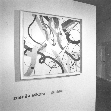texts about zs
Motto: Several times in my life I have had the feeling that I had gone astray in my work. I was slowly drawn into each new situation by forces that I could not, and even did not want to resist. The new results always struck me as being foreign, even though they were created spontaneously and were not the result of a decision or intention. Always after a longer period of time, I started to understand them and I realized that they had preceded my thoughts.
- Zdeněk Sýkora, in a dialogue with Vítek Čapek, 1985
Zdeněk Sýkora, who is always first and foremost described as a painter, has become the Vladimír Boudník Award laureate for 2008. This lifetime achievement award is given to “a living Czech printmaker who has made a significant artistic contribution in the area of fine printmaking”. Several exhibitions of Sýkora’s prints in the Czech Republic – at the František Drtikol Gallery in Příbram in April, the Caesar Gallery in Olomouc over the summer, the Municipal Gallery in Litvínov in September and the Gallery of the White Unicorn in Klatovy at the end of the year – certainly played a role in Sýkora’s nomination for the award. A selection of Sýkora’s prints was presented at the exhibitions, allowing the public to become acquainted with the lesser-known path of the artist’s development.
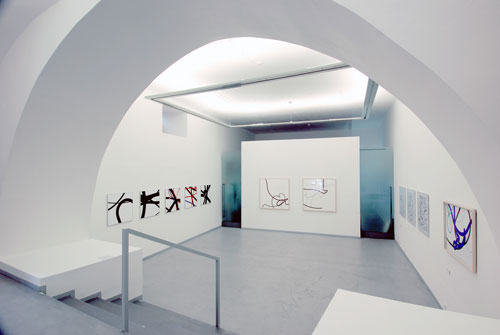
Zdeněk Sýkora’s printed oeuvre, which is not sizable and with only a brief time gap mirrors the evolutionary line of his painted oeuvre, can be observed from various aspects: the book Zdeněk Sýkora - Prints, an English translation of the Czech book designed by Zdeněk Ziegler and published by Gallery in Prague 2008, deals with Sýkora’s prints chronologically as well as in terms of the relationship between Sýkora’s printmaking and painting, as Jaroslav Vančát entitled his study at the opening of the book. The book also recalls the interesting circumstances surrounding the creation of individual imprints, including problems with signing the imprints, the names of the publishers as well as other details, richly illustrated with full-page reproductions and a list of prints, sources and exhibitions (Not all prints that were ever published and signed by Zdeněk Sýkora are shown in Prints. Only those prints that from the outset were created as single and therefore original prints are reproduced there. On the other hand, invitations and posters for exhibitions, book and catalogue supplements and other occasional prints are not included in the publication, even though they were printed as original screenprints /these will be the subject of subsequent volumes of Zdeněk Sýkora’s monograph/).
In this article, however, we endeavour to follow the evolution of the artist’s approach to printmaking as a separate and specific means of artistic expression and describe his path as a printmaker, a route which always ran parallel to his path as a painter.
If we disregard his printmaking attempts connected with his university studies in the 1940s and later minor occasional prints or illustrations for poetry written by his friends, for the most part created using drypoint, lithography or linocut, it can be stated that Zdeněk Sýkora started to become seriously interested in printmaking in 1964. This is where his “parallel path” as a printmaker starts – one which, just like his path as a painter, is often connected with experimentation. This path can be divided into the following stages:
- Attempts are made at using linocut (mid-Sixties)
- An adequate technique is found – screenprinting – for conveying his painted works in print form (starting in the mid-Sixties)
- Prints and paintings are placed on equal stature – new “subjects” in printmaking are sought (starting in the late Eighties)
Let us look at this period in a little more detail and in the context of his artistic development as a painter.
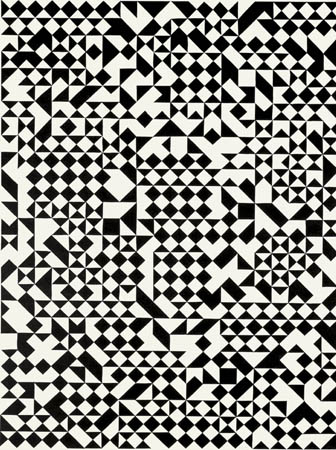 In 1964, Zdeněk Sýkora used linocuts in his first attempts at conveying his Structures in print form. It is remarkable – but characteristic of the artist – that he started to experiment in printmaking as well just one year after he discovered the world of Structures. Starting in 1959, his painting experienced rapid and revolutionary developments: from landscape paintings to flat colour paintings entitled “Gardens” and paintings featuring large geometric elements which became the basis for his entirely new thinking as a painter. In 1962 Zdeněk Sýkora started to create his first painting comprised of elements placed in a grid – Grey Structure (1962 - 63, oil on canvas, 150 x 120 cm, in the holdings of the Benedikt Rejt Gallery, Louny). This step forward was undoubtedly brave and innovative, even though the artist himself was uncertain whether he had taken a wrong turn (see his motto). Despite this, he continued down the path he started and in 1963 painted several additional relatively large-format Structures, one of which – Square Structure, 1963, oil/canvas, 136 x 100 cm, private collection – became the invitation, and in fact the model, for creating prints.
In 1964, Zdeněk Sýkora used linocuts in his first attempts at conveying his Structures in print form. It is remarkable – but characteristic of the artist – that he started to experiment in printmaking as well just one year after he discovered the world of Structures. Starting in 1959, his painting experienced rapid and revolutionary developments: from landscape paintings to flat colour paintings entitled “Gardens” and paintings featuring large geometric elements which became the basis for his entirely new thinking as a painter. In 1962 Zdeněk Sýkora started to create his first painting comprised of elements placed in a grid – Grey Structure (1962 - 63, oil on canvas, 150 x 120 cm, in the holdings of the Benedikt Rejt Gallery, Louny). This step forward was undoubtedly brave and innovative, even though the artist himself was uncertain whether he had taken a wrong turn (see his motto). Despite this, he continued down the path he started and in 1963 painted several additional relatively large-format Structures, one of which – Square Structure, 1963, oil/canvas, 136 x 100 cm, private collection – became the invitation, and in fact the model, for creating prints.
The first attempts at creating Structures prints were linocuts printed under the artist’s supervision in Most in 1964; additional prints were made in 1965. Using this technique, Sýkora attempted to depict colour versions of Structures that had already been created. The use of linocuts proved that this technique is not ideal for this type of Sýkora’s art, though – the printed geometric shapes had wobbly edges and in case of two-colour Structures it would have been impossible to achieve an exact copy. The artist tried to resolve this problem by using paper of various colours and, in the Red-Blue Structure, by printing the entire foundation in one of the colours, but the results did not correspond to his ideas. In these terms, only his double and triple Structures, created by printing several matrixes over one another, could be aesthetically pleasing, yet these as well referred more to Sýkora’s hard-edge paintings than to the Structures themselves.
As a result, Sýkora’s printmaking advances to the second stage: the artist discovers the technique of screenprinting for creating his prints.
We hope it will not bore the informed readers of this art magazine when we note that the opinion regarding screenprinting as an artistic printmaking technique was never very clear. Whereas all the prejudices against screenprinting were gradually overcome in Western Europe in the Sixties and, later on, enthusiastically received by both artists and critics – particularly under the influence of American art culture (one primary example is Andy Warhol) represented at numerous contemporary art exhibitions – at that time in Czechoslovakia the artistic originality of screenprinting was considered questionable and many viewed it as merely a high-quality form of reproduction.
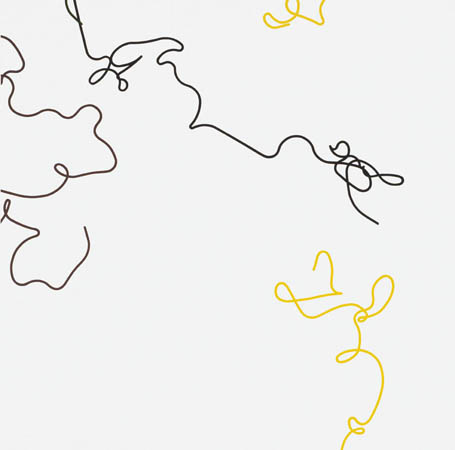 As Zdeněk Sýkora was never prejudiced against anything new – without this trait it would be difficult to imagine that he would have been able to start using a computer in his art in 1964 – in 1967 he unhesitatingly accepted the offer of a German gallery owner in Hannover, August Haseke, to create the square Red-Blue Structure as a screenprint. This allowed Sýkora to verify that this printmaking technique is much more suitable for conveying his Structures in prints as it permitted him to predefine the colours and print precisely-defined geometric forms. As opposed to the linocuts, the resulting print resembled the Structure oil paintings much more in terms of character. It was no less important that screenprinting allows prepared designs to be transferred into print form fairly simply, using photographs or slides, practically without the direct involvement of the artist. This is an aspect which, in that period of restricted international travel, proved to be essential for Sýkora’s screenprints to come into being; without this condition his entire printed oeuvre from the Seventies and Eighties would not have been made, as nearly all of his Structures prints (as well as several of his first Lines prints) were printed in the West.
As Zdeněk Sýkora was never prejudiced against anything new – without this trait it would be difficult to imagine that he would have been able to start using a computer in his art in 1964 – in 1967 he unhesitatingly accepted the offer of a German gallery owner in Hannover, August Haseke, to create the square Red-Blue Structure as a screenprint. This allowed Sýkora to verify that this printmaking technique is much more suitable for conveying his Structures in prints as it permitted him to predefine the colours and print precisely-defined geometric forms. As opposed to the linocuts, the resulting print resembled the Structure oil paintings much more in terms of character. It was no less important that screenprinting allows prepared designs to be transferred into print form fairly simply, using photographs or slides, practically without the direct involvement of the artist. This is an aspect which, in that period of restricted international travel, proved to be essential for Sýkora’s screenprints to come into being; without this condition his entire printed oeuvre from the Seventies and Eighties would not have been made, as nearly all of his Structures prints (as well as several of his first Lines prints) were printed in the West.
Sýkora’s Structures prints were always created in connection with specific completed paintings, but they were never copies of the paintings – first and foremost they had different dimensions, they often contain different colours, and some are just parts or details of a particular painting. Unlike with his paintings, the artist also tried several differing colour versions of the same motif; alternatively, as with his paintings he later visualised his thesis of the unrestricted, infinite nature of Structures by tilting the grid. In the late Sixties he went so far as to alter some of his older prints by cropping the format, again in accordance with the experiments he conducted in his own painting.
Nor did Zdeněk Sýkora abandon the screenprinting technique later, as it suited all of the demands he placed on printmaking media when he decided to make prints on the new subject of his paintings: Lines, connected with the new element of chance. Lines first appeared in his paintings in 1973, but the first prints were made in as late as 1980 (the Lines album). His method for transferring his works to prints were, for the time, the same as for Structures – via slides, also making these first Lines prints “identifiable” with paintings.
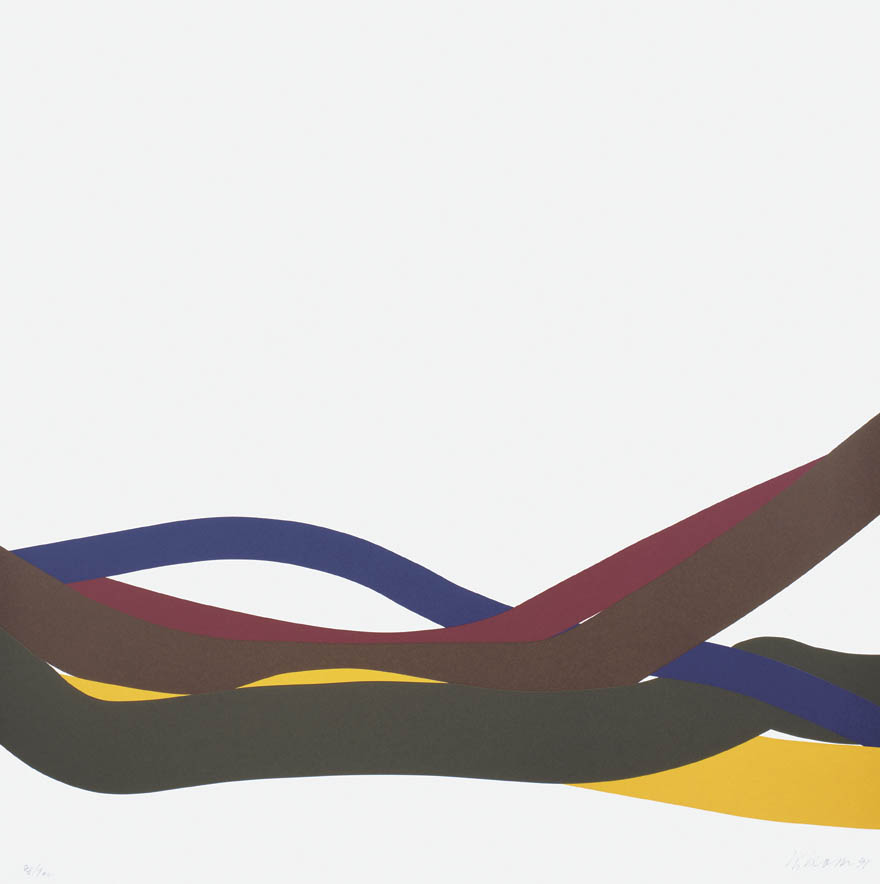 In terms of the artist’s approach to his printmaking, 1986 was a watershed year: Zdeněk Sýkora created his first screenprint on the basis of an original drawing, thus practically placing his painting and printmaking on equal stature. The Lines prints are created based on the same principle as the paintings: according to a new assignment, a system and score is created for the print and random numbers are entered into it; an original drawing is created that is the basis for printing; colours are limited in number, but selected randomly (For the sake of precision, there are exceptions to this rule – several screenprints have been created that refer directly to already completed paintings, such as Lines No. 63 and Lines No. 197). Clearly this printmaking is different from painting – the prints are restricted by the technology of screenprinting. Whereas in painting it is possible to work with an unlimited number of lines, each having their own colour, other rules are in force for screenprints (i.e. the greater the number of colours, the greater the risk that there will be imprecision when making imprints); the screen format is also restricted. The creation of preparatory drawings for these “original” screenprints often required as much time as for preparing the paintings themselves. Despite this, or perhaps precisely because of this, this new approach brought the artist similar emotions as the ones he had experienced only in painting – the feeling of surprise from a newly created reality.
In terms of the artist’s approach to his printmaking, 1986 was a watershed year: Zdeněk Sýkora created his first screenprint on the basis of an original drawing, thus practically placing his painting and printmaking on equal stature. The Lines prints are created based on the same principle as the paintings: according to a new assignment, a system and score is created for the print and random numbers are entered into it; an original drawing is created that is the basis for printing; colours are limited in number, but selected randomly (For the sake of precision, there are exceptions to this rule – several screenprints have been created that refer directly to already completed paintings, such as Lines No. 63 and Lines No. 197). Clearly this printmaking is different from painting – the prints are restricted by the technology of screenprinting. Whereas in painting it is possible to work with an unlimited number of lines, each having their own colour, other rules are in force for screenprints (i.e. the greater the number of colours, the greater the risk that there will be imprecision when making imprints); the screen format is also restricted. The creation of preparatory drawings for these “original” screenprints often required as much time as for preparing the paintings themselves. Despite this, or perhaps precisely because of this, this new approach brought the artist similar emotions as the ones he had experienced only in painting – the feeling of surprise from a newly created reality.
At the same time we would like to note that even though Sýkora’s Lines prints were always created from an external impetus (mostly for exhibitions), the artist proposed the “subject matter” himself. As a rule these were projects in which he could try out something new that was not possible to do on a painting, such as return to a certain phase of a completed painting (Phase No. 31), select a detail and see how it operated (Detail No. 21), try out a number of variations on the same thing (100 Lines), see the painting in different phases of its creation (Three Phases) or try out an unusual format (Prone).
Zdeněk Sýkora embarked on his “parallel path” with the same confidence as in his painting. Both of these paths are connected by his constant searching, experimenting and creative approach. Nor in his printmaking did he rest on his laurels; the path never ended for him.
In conclusion we would like to highlight several names of the publishers, and particularly the printers of the screenprints, as their contribution to the quality of Sýkora’s printmaking is huge and certainly a large part of the Vladimír Boudník Award which Zdeněk Sýkora has just received belongs to them.
For the artist who decides to create screenprints it is always of utmost importance to collaborate with good, experienced printers and editors, and Zdeněk Sýkora was lucky to have encountered them along his path.
In the 1970s it was particularly Galerie Edition Hoffmann that proved its high quality for Structures prints. Over the past several decades, this German publisher has focussed on mapping out all 20th Century tendencies in geometric abstraction, and its portfolio of editions it regularly publishes includes the leading representatives of these tendencies from throughout the world (Leon Polk Smith, Henryk Stazewski, Heijo Hangen, Richard Paul Lohse, Lev Nusberg, Bob Bonies and others). It is also due to this gallery that Zdeněk Sýkora’s name was placed in the context of international art. We would like to note that it is here where two of Sýkora’s exceptional Structures screenprints printed on PVC (1970) were published. From today’s perspective this can appear courageous, but experimenting with plastics was characteristic for Sixties and Seventies art and it can also be found in Zdeněk Sýkora’s “paintings” and sculptures: in the latter half of the 1960s, he created several Structures comprised of plastic elements as well as several objects made of Novodur (a type of hard PVC).
Following the “Velvet Revolution” in 1989, when all of the country’s subjective and objective restrictions for this type of printmaking fell, Zdeněk Sýkora started to also collaborate with Czech screenprint publishers. The first of these was gallery owner Zdeněk Sklenář, who in 1993 published 27 Lines as part of the Czech Prints I album. Since then, thanks to him nearly ten screenprints have been created; his last project was the Flying album (2007).
Zdeněk Křenek has become another important editor of Sýkora’s screenprints. Křenek’s Aulus Publishers issued four editions together with four fine press publications that Zdeněk Sýkora illustrated with his screenprints. The names of the screenprints – 13 Lines for Jan Neruda, 13 Lines for Stephen Hawking, The Sound and the Fury, 13 Lines for Karel Hynek Mácha – refer to the authors of these books.
Crucial for the technical quality of Sýkora’s Lines prints was his good fortune in finding and working with Antonín Komárek and René Řebec from the printmaking workshop at the Academy of Arts, Architecture and Design in Prague; Komárek and Řebec printed all the Lines prints published in the Czech Republic and achieved absolute mastery in the field.
Outside of the country, the Swiss printer and gallery owner Marc Hostettler
remains the expert in printing Zdeněk Sýkora’s work; his Editions Média in Neuchâtel published and he himself printed the greatest number of his screenprints. Hostettler’s high quality and experience is demonstrated in the names of the international artists whose works he has published as screenprints (such as Max Bill, Richard Paul Lohse, Kenneth Martin, Manfred Mohr, François Morellet, Jan Schoonhoven etc.).
The artist sincerely thanks all those named here as well as to the many others who we have not been able to mention due to space considerations.
Lenka Sýkorová, 2008
Written after Zdeněk Sýkora became the Vladimír Boudník Award laureate for 2008
In Grapheion, 2008, No. 21, pp. 4-11
Author: Lenka Sýkorová, 2008
Topic: prints


